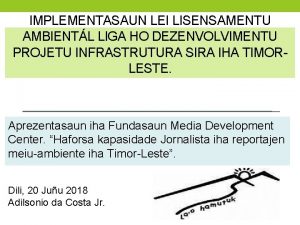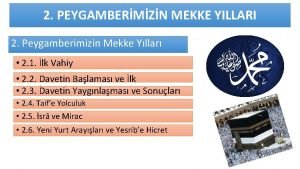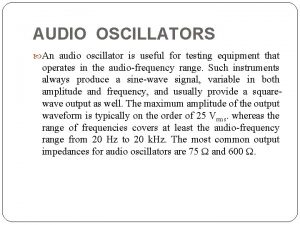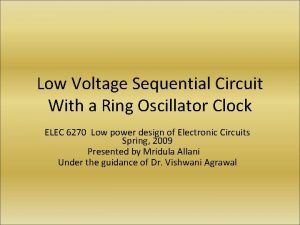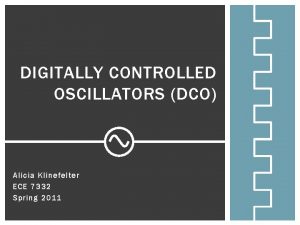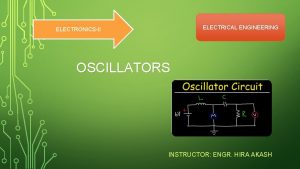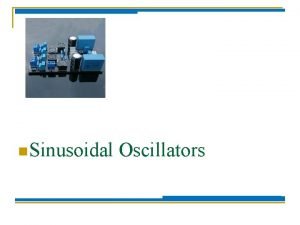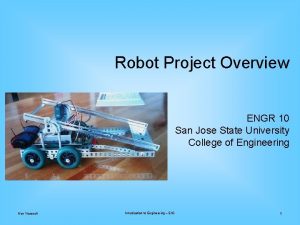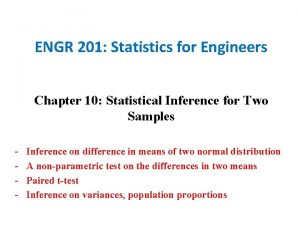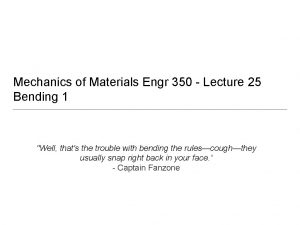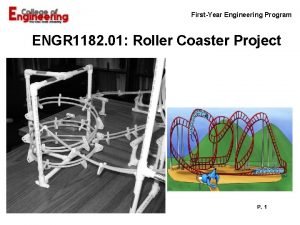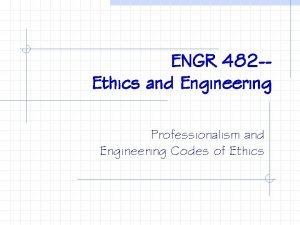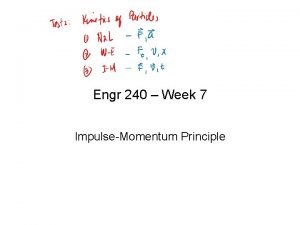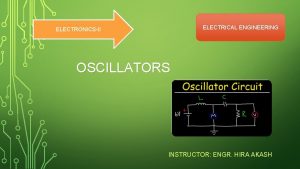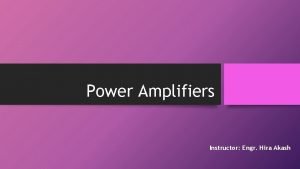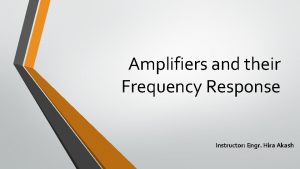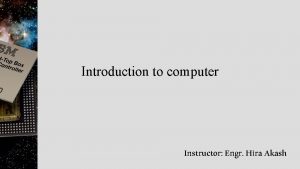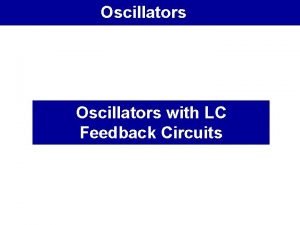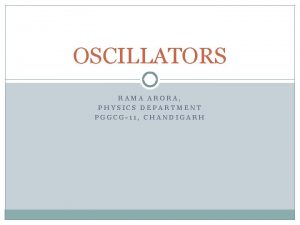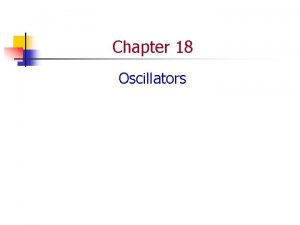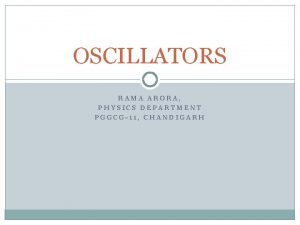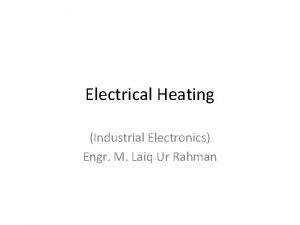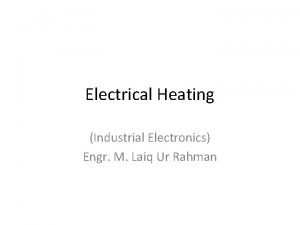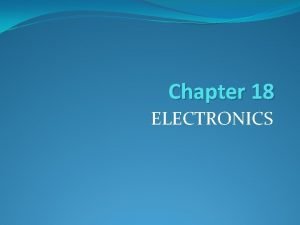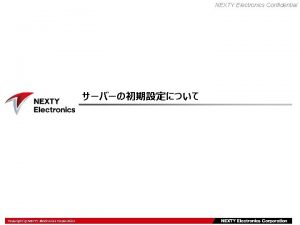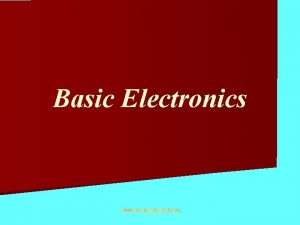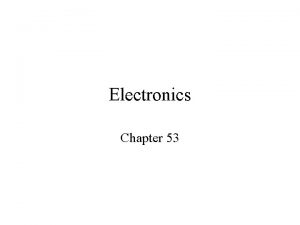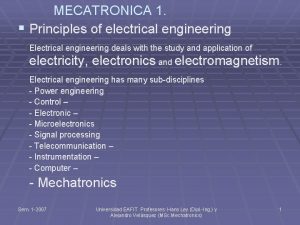ELECTRICAL ENGINEERING ELECTRONICS II OSCILLATORS INSTRUCTOR ENGR HIRA

























- Slides: 25

ELECTRICAL ENGINEERING ELECTRONICS II OSCILLATORS INSTRUCTOR: ENGR. HIRA AKASH

OSCILLATORS: • 3. 1 Introduction and Classification of oscillators 3. 2 Damped and undamped oscillators 3. 3 The oscillatory circuit 3. 4 Frequency stability of an oscillator 3. 5 Essentials of a feedback LC oscillator 3. 6 Tuned base oscillator. INSTRUCTOR: ENGR. HIRA AKASH

OSCILLATORS • Oscillators designed to produce a high power AC output from a DC supply are usually called inverters. There are two main types of electronic oscillator – the linear or harmonic oscillator and the nonlinear or relaxation oscillator. Or • An electronic oscillator is an electronic circuit that produces a repetitive, oscillating electronic signal, often a sine wave or a square wave. • Oscillators convert direct current (DC) from a power supply to an alternating current signal. • They are widely used in many electronic devices. • Common examples of signals generated by oscillators include signals broadcast INSTRUCTOR: ENGR. HIRA AKASH by radio and television transmitters, clock signals that regulate computers and quartz clocks, and the sounds produced by electronic beepers and video games.

• Any circuit which is used to generate a. c. voltage without a. c. the input signal is called an oscillator. • To generate a. c. voltage. the circuit is supplied energy from a d. c. source. • If the output voltage is a sine wave function of time, the oscillator is called a "sinusoidal" or "Harmonic" oscillator. • Positive feedback and negative resistance oscillators belong to this category. • There is another category of oscillators which generate non sinusoidal waveforms such as square, rectangular, triangular or sawtooth waves. INSTRUCTOR: ENGR. HIRA AKASH

OSCILLATORS CLASSIFICATION: Oscillators are classified in the following different ways. 1. According to the waveforms generated: (a) Sinusoidal oscillator (b) Relaxation oscillator INSTRUCTOR: ENGR. HIRA AKASH

SINUSOIDAL OSCILLATOR • Sinusoidal oscillator generates sinusoidal voltage or currents as shown in fig. below. INSTRUCTOR: ENGR. HIRA AKASH

RELAXATION OSCILLATOR • Relaxation oscillator generates voltages or currents which vary abruptly one or more times in a cycle of oscillation as shown in fig. below INSTRUCTOR: ENGR. HIRA AKASH

ACCORDING TO THE FUNDAMENTAL MECHANISMS INVOLVED : (a) Negative resistance oscillators (b) Feedback oscillators INSTRUCTOR: ENGR. HIRA AKASH

Negative resistance oscillators use the negative resistance of the amplifying device to neutralize the positive resistance of the oscillator. Feedback oscillators use positive feedback in the feedback amplifier to satisfy the Barkhausen criterion. INSTRUCTOR: ENGR. HIRA AKASH

BARKHAUSEN CRITERION(CONDITIONS FOR OSCILLATION): • The essential conditions for maintaining oscillations are : 1. |AB|=1, i. e. the magnitude of loop gain must be unity 2. The total phase shift around the closed loop is zero or 360 degrees. INSTRUCTOR: ENGR. HIRA AKASH

DAMPED OSCILLATIONS • The electronic oscillations whose amplitude goes on decreasing with time due to the losses inherent in the electrical system in which oscillations are generated are called damped oscillations. • • It refers to an oscillation that fades away with time. • As the energy is proportional to the square of the amplitude, the amplitude decreases gradually until the oscillator returns to equilibrium. • The oscillator circuits then produce the damped oscillations. However, the frequency of oscillation remains unchanged because it depends on the circuit parameters. • The best example of a damped oscillation is a swinging pendulum, in which the vibration slows down and stops over time. An oscillator is always subject to forces, which dissipate a part of the oscillator energy as heat, or in other forms. INSTRUCTOR: ENGR. HIRA AKASH

INSTRUCTOR: ENGR. HIRA AKASH

UNDAMPED OSCILLATION • If the losses incurred in the electrical system could be compensated, the amplitude of oscillation would remain constant and as such the oscillation would continue indefinitely against both external disturbances and changes in the initial conditions. • • This type of oscillation is called undamped oscillation. • Systems which can generate such oscillations are called self excited oscillating systems and they are maintained by an external energy source in a non linear dissipative system. • If the oscillator produces undamped oscillations, then there are no power losses or provisions to compensate for the power losses. So, simply put, the oscillations whose amplitude remains constant with time are called undamped oscillations. INSTRUCTOR: ENGR. HIRA AKASH

INSTRUCTOR: ENGR. HIRA AKASH

OSCILLATORY CIRCUIT • Circuit containing inductance or capacitance, or both, and resistance, connected so that a voltage impulse will produce an output current whi ch periodically reverses or oscillates. INSTRUCTOR: ENGR. HIRA AKASH

FREQUENCY STABILITY OF AN OSCILLATOR • Even if an oscillator is set at an initial frequency, it cannot be maintained throughout. • They keep on changing either in a uniform way or sometimes erratically. • The term “frequency stability” is used to define the ability of the oscillator to maintain a single fixed frequency as long as possible over a time interval. • These deviations in frequency are caused due to variations in the values of circuit features (circuit components, transistor parameters, supply voltages, stray capacitances, output load etc. ) that determine the oscillator frequency. INSTRUCTOR: ENGR. HIRA AKASH

FACTORS RESPONSIBLE FOR DRIFT IN OSCILLATOR FREQUENCY Other factors responsible for drift in oscillator frequency are given below. • Operating point of active device – The effects of variations in inter element capacitances can be neutralized by introducing a swamping capacitor across the offending elements (the introduced capacitor becomes the part of the tank circuit). • Inter element capacitances – If the operating point of the active device in the circuit is in the non linear portion of its characteristics, there may be variations in the transistor parameters which, in turn, affects the oscillator frequency stability. So, the operating point, Q is carefully selected to work in the linear portion of the characteristics of the active device. INSTRUCTOR: ENGR. HIRA AKASH

• Mechanical vibrations – Although the mechanical vibrations is not such a high frequency stability changing factor, they can be easily avoided by isolating the oscillator circuit from the source of mechanical vibrations. • When the circuit operates for a long time, the heat starts to build up. As a result, the values of the frequency determining components like resistors, inductors and capacitors change with temperature. Thus the transistor parameter values also tend to change. But, the change in the values of R, L, and C will be slow and thus the change in oscillator frequency will also be slow. • The other major factor responsible for deviation in frequency is variations in power supply (operating voltage applied to the active device). However, this problem can be overcome by using regulated power supply. Any variation in load coupled to the tank circuit may cause a change in effective resist ance of the circuit by transformer action INSTRUCTOR: ENGR. HIRA AKASH which, in turn, causes the drift in frequency

ESSENTIALS OF A FEEDBACK LC OSCILLATOR INSTRUCTOR: ENGR. HIRA AKASH

Fig shows the block diagram of an oscillator. Its essential components are (i) tank circuit, (ii) amplifier and (iii) feedback circuit. (i) Tank circuit : It consists of inductance coil (L) connected in parallel with capacitor (C). The frequency of oscillations in the circuit depends upon the values of inductance coil and capacitance of the capacitor. (ii) Amplifier : The transistor amplifier receives d. c. power from the battery and changes it into a. c. power for supplying to the tank circuit. (iii) Feedback circuit : It provides positive feedback (i. e. ) this circuit transfers a part of output energy to LC circuit in proper phase, to maintain the oscillations. INSTRUCTOR: ENGR. HIRA AKASH

OSCILLATOR BLOCK DIAGRAM INSTRUCTOR: ENGR. HIRA AKASH

• A transistor can work as an LC oscillator to produce undamped oscillations of any desired frequency, if tank and feedback circuits are properly connected to it. There are different LC oscillators used in electronic circuits, of which, the working principle of Colpitt's oscillator is discussed here. INSTRUCTOR: ENGR. HIRA AKASH

TUNED BASE OSCILLATOR • Tune base oscillator is another type of transistor based LC oscillator where the tuned circuit (tank circuit) is placed between the base and ground of the transistor. The tuned base oscillator is also called “Armstrong oscillator” after the name of its inventor. INSTRUCTOR: ENGR. HIRA AKASH

BASIC PRINCIPLE OF OSCILLATOR • There are many types of electronic oscillators, but they all operate according to the same basic principle: an oscillator always employs a sensitive amplifier whose output is fed back to the input in phase. • Thus, the signal regenerates and sustains itself. This is known as positive feedback. INSTRUCTOR: ENGR. HIRA AKASH

Thank you!! END INSTRUCTOR: ENGR. HIRA AKASH
 Objetivu husi ambiente
Objetivu husi ambiente Risk assessment table
Risk assessment table Nur dağı hira mağarası nerede
Nur dağı hira mağarası nerede Hira
Hira Hira transport inc
Hira transport inc Hira computer solutions
Hira computer solutions Hirac example
Hirac example Hira abbas
Hira abbas What is an audio oscillator used for
What is an audio oscillator used for Low g oscillators 50low
Low g oscillators 50low Alicia klinefelter
Alicia klinefelter The figure shows four oscillators at t=0
The figure shows four oscillators at t=0 Classification of oscillators
Classification of oscillators Sinusoidal oscillators are
Sinusoidal oscillators are Engineering 1181
Engineering 1181 Sjsu engr 10
Sjsu engr 10 Engr 201
Engr 201 Engr 1182
Engr 1182 Engr 350
Engr 350 Performance task: roller coaster design
Performance task: roller coaster design Tamu engr 482
Tamu engr 482 Engr 1330
Engr 1330 Engr 1330 ttu
Engr 1330 ttu Engr 112
Engr 112 Perfectly plastic collision
Perfectly plastic collision Engr 10 sjsu
Engr 10 sjsu
